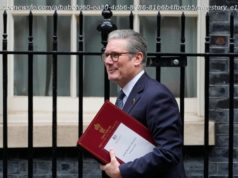Employers added a better-than-expected 200,000 jobs and wages grew at their fastest pace since the recession.
The labor market perked up in January as U. S. employers added a better-than-expected 200,000 jobs and wages grew at their fastest pace since the recession, fresh signs that hiring could remain solid this year despite a low unemployment rate that’s creating worker shortages.
The unemployment rate, which is calculated from a different survey, remained steady, as expected, at 4.1%, the Labor Department said Friday. The jobless rate remained at its lowest level since December 2000.
And in good news for workers, average hourly earnings in January rose 2.9% vs. a year ago, up from a 2.5% rate in December and above economists’ projections of 2.6%. The nearly 3% jump in pay marks the fastest pace since the middle of 2009, just as the economy was emerging from the Great Recession, according to Nationwide’s chief economist David Berson.
«The faster pace of wage gains indicates that the labor market is tightening, with employers having to pay higher wages to get the workers they want,» Berson said.
In January, average hourly earnings for all employees on private non-farm payrolls rose by 9 cents to $26.74, following an 11-cent gain in December.
The number of jobs created in December was revised higher by 12,000 jobs to 160,000, further reducing fears that employment might be slowing.
More: Economy grew solid 2.6% in Q4 but less than expected
More: Jobs market: Labor shortage means longer hours but more cash for workers
Hiring appeared to slow late last year, possibly reflecting a low jobless rate that has diminished the pool of available workers. Many economists expect average monthly job growth to moderate further to about 160,000 in 2018 from about 170,000 last year as workers shortages intensify in a solidly-growing economy.
The strong hiring at the start of the year is a positive for U. S. workers. But the robust employment market could pressure the Federal Reserve to raise interest rates more quickly than expected this year to ensure inflation doesn’t spike and the economy doesn’t overheat, said Luke Bartholomew, an investment strategist at Aberdeen Standard Investments.
“This is a much stronger outcome than most expected,» Bartholomew said. «The headline unemployment number is good but the wage growth is really positive,» he continued, adding, «It definitely makes it a bit more likely that the Fed will have to do more than the three hikes that they’re currently planning for this year.»
The continued strength in employment «leaves the Fed firmly on track to raise rates at its next meeting in March,» said Andrew Hunter, U. S. economist at Capital Economics.
Reaction in the U. S. government bond market showed that investors think the Fed could move more aggressively. The yield on the 10-year Treasury note, which moves in the opposite direction of its price, jumped above 2.8% for the first time since April 2014, leaving yields at their highest level in nearly four years.
January’s job gains were broad. Employment continued to trend up in construction, food services and drinking places, health care, and manufacturing. Construction added 36,000 jobs. Employment in residential building construction rose by 5,000. .
Employers in food services and drinking places added 31,000 jobs. Health care added 21,000 jobs, with a gain of 13,000 in hospitals. Manufacturing jobs grew by 15,000, while durable goods industries added 18,000 jobs.
The job count for November, however, was revised lower by 36,000 to 216,000.






